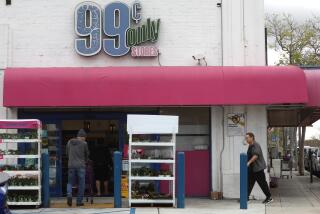You Won’t <i> Ever</i> See a Sale Like This Again! (Until Tomorrow)
This is your last chance to read this column.
It’s my going-out-of-business sale. Read it before it’s gone. Today only!
Marketers know there are few more effective sales pitches than the two words last chance . The Labor Day weekend was littered with “last chance” and “clearance” sales--everywhere from Nissan car dealerships to the Broadway department stores to Paul’s Big Screen Television. Consultants say that during the recent economic downturn, marketers stressed urgency in order to coax consumers to buy. It worked so well that the mantra continues.
“No one wants to feel left out,” said Harry Noyes, a consumer psychologist and president of Psychological Motivations, a Dobbs Ferry, N.Y., consulting firm. “The chance of missing an opportunity that may not come again is too much for many consumers to pass up.”
We are a nation obsessed with last chances. And, for that matter, second-to-last chances. One Studio City retailer has posted a window sign that reads “Almost Going Out of Business.”
The streets of New York City--particularly along 6th Avenue--are littered with merchants who have claimed for years that they are “going out of business.” Some of the screaming signs, however, actually promise far less than what unwitting consumers perceive. One sign flashing outside a store is worded, “Going Out for Business.” And one Lexington Avenue store recently posted this warning: “Doors Close at 9 p.m. Tonight.” The merchant explained that his doors did close at 9 p.m. that night--and each night thereafter.
*
Consumers who are generally most moved by “last chance” sales are those who grew up in big families, said Dr. Joyce Brothers, the syndicated writer and radio talk show host. “They knew that if they didn’t grab something while it was in front of them, their brother or sister would snatch it.”
C&R; Clothiers, the discount men’s clothing chain based in Culver City, thinks it knows how to get customers into its stores. For three straight years--in fact, several times a year since 1992--it has run “Sale of the Decade” sales.
How can there be more than one “Sale of the Decade?”
“Each one was bigger than the one before it,” explained Paul Reisbord, chairman of C&R; Clothiers, which recently emerged from Chapter 11 bankruptcy protection.
These days, sales are one of the few sure ways to spur consumer attention, said Michael W. Marsak, president of the Marina del Rey consulting firm Effective Marketing Strategies. “Customers live for the two-day sale and retailers live off the two-day sale,” he said.
But the Better Business Bureau says it gets many complaints about boldly advertised sales that don’t live up to their billings.
Some stores advertise they are going out of business and then, when the sale ends, they simply change their name, said Debbie Mahdi, office manager at the BBB’s district office in Cypress.
Back in 1992, she said, the BBB received numerous complaints about RB Furniture’s widely advertised bankruptcy sale, which the company called the “Sale of the Century.” The “sale” dragged on for months before the Los Angeles district attorney’s office sued RB Furniture as well as Gene Rosenberg & Associates, the Newington, Conn.-based liquidator of RB. While each denied wrongdoing, together they paid fines totaling $140,000 to settle false-advertising charges.
Well aware of consumer attraction to urgency, the Los Angeles retail chain Family Bargain Center runs TV and radio ads in English and Spanish each time it has a sale, vowing, “Like everything else at Family Bargain Center, we buy in limited quantities, so when it’s gone, it’s gone.”
The ad man behind the campaign said the rationale is simple. “Retail advertising by definition must have urgency built into it,” said Bruce Silverman, president of the Los Angeles agency Asher/Gould Advertising. “You must say that you have an undeniably good reason for people to buy it right now.”
But with the onslaught of “last chance” sales during the recent recession, some consumers have also been conditioned to understand that, in fact, “there is no last chance,” said Susan Small-Weil, consumer psychologist at the New York ad agency Warwick Baker & Fiore. “If you don’t buy sheets at the ‘White Sale’ in January, you can simply wait for the next ‘White Sale’ in the spring.”
Still, it seems there will always be room to hook consumers with the “last chance.”
I personally learned how well this “last chance” scenario works, when--more than 20 years ago--I spent one long evening trying to peddle soda at college football’s Orange Bowl game in Miami.
*
I was on winter break from college and flew to Miami to visit Mom. I’d read in the newspaper that they needed vendors at the Orange Bowl football game. It sounded like a nifty way to see the game for free--and to make a few nickels.
But selling was a bear. Too much competition. They paid us a nickel for each cup, and by the end of the third quarter, I’d only made about $5. That’s when I changed my tune. For the rest of the game, I roamed the stadium aisles shouting, “Last chance on cola!”
It worked. I left the Orange Bowl that night with more than $25 stuffed into my pockets.
Now I leave The Times, with nearly a decade of Marketing columns stuffed into my scrapbooks. Maybe one or two of them were helpful to some of you.
If not, you might want to read this column again.
After all, it’s your last chance.
More to Read
Inside the business of entertainment
The Wide Shot brings you news, analysis and insights on everything from streaming wars to production — and what it all means for the future.
You may occasionally receive promotional content from the Los Angeles Times.










